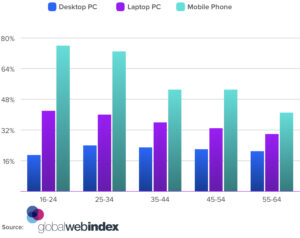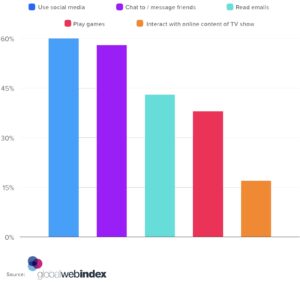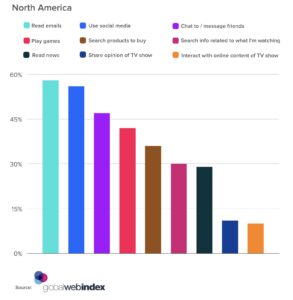Second Screening: Understanding Usage and Audiences

Unlimited access to information and advancements in technology has caused an evolution in the way we consume content. Audiences used to engage with one medium at a time but most viewers are now multitasking with multiple devices. “Second screening” is a term for when viewers are watching television but are also using a secondary electronic device during that time.
Using a mobile device while watching television has been coined “second screen.” This phenomenon has continued to grow in popularity over the past few years and marketers need to keep their eyes on the effect of the second screen when it comes to media consumption and advertising.
Digital Turbine analyzed survey data from Global Web Index to better understand second screen audiences, which devices consumers are using as second screens, and what activities they are doing.
Mobile is the Dominant Second Screening Device
Consumers from across the globe were asked which devices they often use while watching television. A majority of respondents (67%) said they use their mobile phone. Laptop PC and desktop PC came in at second and third at 38% and 22% respectively. This should not come as shock to most as mobile usage has on the rise for the past several years. Gone are the days when audiences gave their undivided attention to TV.
When a target audience uses multiple screens simultaneously, advertisers have the opportunity to reinforce the messaging from the first screen by serving ads on the second screen or circumventing the total disconnect from the first by reaching consumers on their phones. Mobile advertising and in-app in particular allow for more interactive creative, allowing to enhance the TV ad experience by adding an interactive component on mobile to further engage the viewer.
Second Screeners of All Ages
Second screening via mobile is incredibly common across all the major generations marketers care about. Unsurprisingly, Gen Z and Millennial viewers are most likely to use their mobile phones while watching TV with shares of 76% and 73% respectively. Gen Z has spent most of their lives multitasking with media as they were introduced to smartphones at very young ages. While some older Millennials remember a time where they watched TV without the distraction of another device, they have adapted to second screening and have adopted it as a regular activity.
 Older viewers may have picked up second screening on mobile later in life but it has become a habitual way of consuming media for most of them. 65% of internet users aged 35-44 said they used their mobile phones often while watching television. More than half of users (53%) aged 45-54 also said they second screened with their smartphones. A significant number of Baby Boomers (41%) are still using their mobile devices as second screens and we expect this share to grow as they become more accustomed to multitasking with media.
Older viewers may have picked up second screening on mobile later in life but it has become a habitual way of consuming media for most of them. 65% of internet users aged 35-44 said they used their mobile phones often while watching television. More than half of users (53%) aged 45-54 also said they second screened with their smartphones. A significant number of Baby Boomers (41%) are still using their mobile devices as second screens and we expect this share to grow as they become more accustomed to multitasking with media.
Second Screening Is An International Practice
According to GWI’s data, the act of using a mobile device as a second screen while watching television is not limited to a specific region; it has been adopted worldwide. Internet users in the Middle East and Africa and Asia-Pacific are the most likely to second screen with a mobile phone with shares of 77% and 74% respectively. Brands may not be surprised to see such a high share in Asia-Pacific given the history of technology in that region but they should not overlook the major advertising opportunities in the Middle East and Africa.
Second screening with a phone is still quite prevalent in other regions as well. In Latin America, 71% of internet users said they are on their phones while watching TV while half of Europeans and just under half of North Americans said the same. Looking at countries specifically, the largest shares of mobile second screeners come from Colombia (90%), Kenya (85%), and Romania (84%).
Advertisers looking to reach these audiences should keep track of major live television events in those countries. This presents a large opportunity for brands to reach their target audience by planning mobile advertising campaigns around live events to reinforce their messaging.
Second Screen Activities
It’s no surprise that TV consumption has remained steady throughout the global pandemic. In addition to that one screening activity, users are also looking for a second device to occupy their time while watching TV. 38% of all Internet users are playing games while watching TV.
Other passive activities that users are engaging with include social media, messaging friends, and reading emails. Because users are already consuming media through one device (TV), it can be assumed that those who are also playing games are doing so through a mobile device, as 67% of users are on a mobile device while watching TV. That 38% of consumers that are playing games while watching TV are looking to be fully engaged in another media-based activity in addition to TV. Targeting these consumers is important as they are opting into another interactive activity while watching TV as opposed to passively responding to content through communication tools (socials, emails, texts).

While gamers are often stereotyped as adolescents and young twenty-somethings, the age range interested in playing games while watching TV spans from 16-64 years old.
The highest percentage of users playing games as their second screen activity falls in the 16-24 range (47%), but just below that are those users in the 25-34 range at 42%. Though the highest percentages of gamers fall in the Gen Z and Millennial generations, 22-33% of Internet users between the ages of 35-64 also choose to play games with their television consumption.
Second Screen Variations By Region
Mobile gaming continues to increase across the United States, but that trend is not limited to the U.S. While gaming as a second activity to watching TV is highest in North America (42%), Asia-Pacific falls only shortly behind with 38%.
The other three regions fall just below Asia-Pacific with Europe at 37% and Latin America and the Middle East and Africa both at 34%. More specifically, over half of the populations in Turkey (54%), Thailand (52%), and the Philippines (52%) play games while watching TV.
Targeting users in these countries through mobile gaming will yield better results as the chances are higher that they will be engaging with mobile games in addition to being involved with other activities. It is also important to note what users are not interested in engaging with while watching TV.
As a second activity, users are not interested in interacting with the online content of the TV show, sharing their opinions of the TV show, or searching for information related to what they are watching. It is more valuable to reach users through gaming, an activity that requires full attention, rather than through the television show or content related to the show.

Focusing on advertising through mobile gaming (instead of television shows or content related to those shows) will reach audiences that are choosing to actively engage with that activity.
Users that are flipping through communication tools, like social media or emails, are passively engaging with the content. With mobile gaming, however, users are making the choice to actively interact with the platform in front of them. Targeting those users is essential in order to maximize reach and influence decision-making within the chosen audience.
Sign-Up
straight to your inbox.






